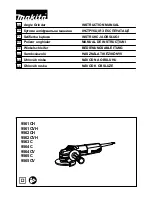
12
Starting the Nitro Engine
3. Turn on your radio system and attach a
fully charged glow igniter (DYN1925) to
the glow plug. Insert the starting wand
into the Tiger Drive and actuate the
starting switch until the engine begins to
run. If the engine does not start, place
your index finger over the carburetor and
actuate the starter until you see fuel enter
the carburetor through the fuel line.
Note
: Stop operation immediately if the
engine enters a hydro-locked condition, as
serious engine damage may occur. Remove
the glow plug, invert the boat and operate
the starter to remove raw fuel before
resuming operation.
You may have to “blip” the throttle on the
transmitter (applying throttle on/off) while trying
to start the engine. New engines are harder
to start because of the tight piston/sleeve fit.
Never start an engine at more than 1/2 throttle,
as this will cause over-revving, which may cause
premature wear and breakage.
During the first tank of fuel, advance the
idle via the idle adjustment screw more than
normal to prevent stalling at idle due to the
rich fuel mixture for break-in. Pinch the fuel
line nearest the carburetor to stop the engine.
Breaking In Your Engine
During break-in, the low-speed needle should
be slightly rich and the high-speed needle
should be very rich. After a few tanks of
fuel, begin to lean the engine out. Adjust the
high-speed needle 1⁄16 of a turn at a time. It
generally takes about five to six tanks of fuel
before you want to lean out the engine until it
supplies good power. Do not skip this process
of break-in. Failure to follow this procedure
could damage your new engine. For further
details on breaking in your engine, please see
the separate engine instruction manual.
Note
: It is common for an ABC engine
to go through a glow plug or two during
break-in.
Needle Settings
When adjusting the settings, always adjust
the needles in small increments, about 1⁄8 of
a full turn at a time. Do not set the engine
too lean, as it shortens the life of the engine.
After you have attained the correct needle
settings, the engine will have a strong-
sounding, high-pitched whine at full speed,
and a thin trail of blue/white smoke will come
from the exhaust.
The low-end needle adjustment determines
how the engine transitions from idle to full
throttle. Once the high-speed needle is set,
adjust the low-end needle clockwise until a
smooth transition is obtained, then back it
out 1/4 turn.
Idle Adjustment
The last setting to set is the idle screw. To
obtain a higher idle, turn the idle screw
clockwise; for lower idle, turn the idle screw
counterclockwise.






































